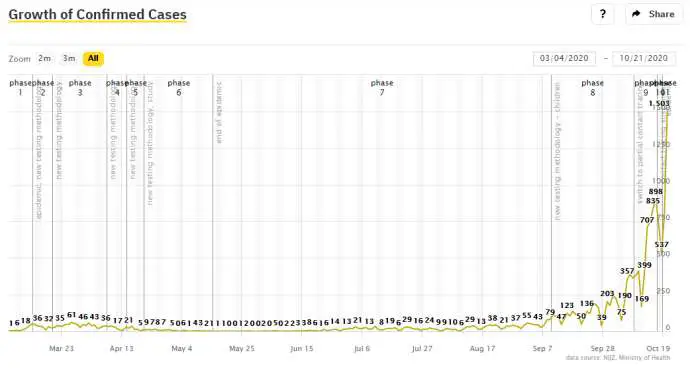STA, 21 October 2020 - A record 1,503 Sars-CoV-2 infections were confirmed in Slovenia on Tuesday, up considerably from the previous daily high of 898, recorded on Friday, as the test positivity rate exceeded 25%, show the latest official data. In the deadliest day yet, eight Covid-19 patients died, raising the death toll to 200.
Covid-19 hospitalisations rose by 20 to 333 despite 32 patients being discharged yesterday. The number of Covid-19 patients in intensive care decreased by one to 55, but the number of those being mechanically ventilated increased by three to 41.
Presenting the latest figures at a press briefing that moved fully online, government spokesman Jelko Kacin said that 5,891 tests had been performed on Tuesday, which means the positivity rate hit 25.5%.
He said that new local virus hotspots were appearing across the country, in particular in the north-western region of Gorenjska, which has the highest incidence rate at the moment.
Data from the tracker site covid-19.sledilnik.org show that the latest cases bring the number of currently active cases to 8,860 and the total case count to 15,982. The rolling 14-day average per 100,000 residents has increased to 423.
The new surge comes after a series of new restrictions have come into effect, including a 9pm-6am curfew last night. Kacin said that while a great majority understood and abided by the measures, some individuals would not and would not help.
This was after a group of protesters gathered in Maribor late last night to demonstrate their opposition to the curfew. PM Janez Janša responded with a tweet in which he revealed that the number of new cases had already surpassed 1,100 and urged the protesters to "get serious".
Kacin, as well as Tatjana Lejko Zupanc, the head of the Infectious Disease Department of the Ljubljana UKC hospital, Slovenia's main Covid-19 facility, appealed on everyone to say at home as much as possible, and urged employers to enable their employees to work from home whenever possible.
However, Lejko Zupanc did not answer in the affirmative when asked whether she thought public life should be brought to a halt completely, noting that it had stopped in a way and that a shutdown of kindergartens, for example, would affect health staff, which was badly needed.
Asked whether Slovenia was reaching a point seen in Italy in spring when doctors would have to chose whom to treat as a priority, Lejko Zupanc said: "We're far from being there, and we'll prevent that if we can (...) I hope and believe we won't reach that point."
The official said the UKC Ljubljana medical centre was working on securing extra beds to cope with the expected influx in Covid-19 patients requiring hospital treatment. With the expansions, UKC Ljubljana will have 40 to 50 intensive care beds and 170 regular hospital beds, which should do to weather the crisis.
She said the medical centre had capacities for further expansion if needed, but a bigger problem was staff. Final year medical students, volunteers and retired health staff have been asked to help alleviate the burden on overworked staff, and staff reassignments between departments are planned.
Lejko Zupanc revealed that five children with Covid-19 were being treated at UKC Ljubljana and 92 adults. Twenty one are receiving intensive care, and most of them are on ventilators.
According to the Jožef Stefan Institute (IJS), Slovenia's reproduction number, showing how many people one infected person will pass the virus on to, has climbed to 2.18, while the epidemic has been spreading with a doubling time of 6.2 days.
The institute estimates that 1.5% of the population is currently infected or one in 70 people, and the share is rising fast.
In the first wave, about 1% of the people got infected. At the peak of the first wave 0.35% of the population was infected or one in 300 people.
In the second wave, 2.5% of the people have been infected so far or one in 40 people. In total, 3.5% of Slovenians have caught the virus so far or one in 30 people.
The IJS expects the measures introduced at the end of last week to start having an impact at the end of the week, while the measures that the government adopted on Tuesday should show next week.
All our stories on Slovenia and coronavirus. The latest statistics on coronavirus and Slovenia, and the latest police news on red, green and yellow list countries. All our stories on coronavirus and Slovenia. Can I transit Slovenia? Find out from the police...






